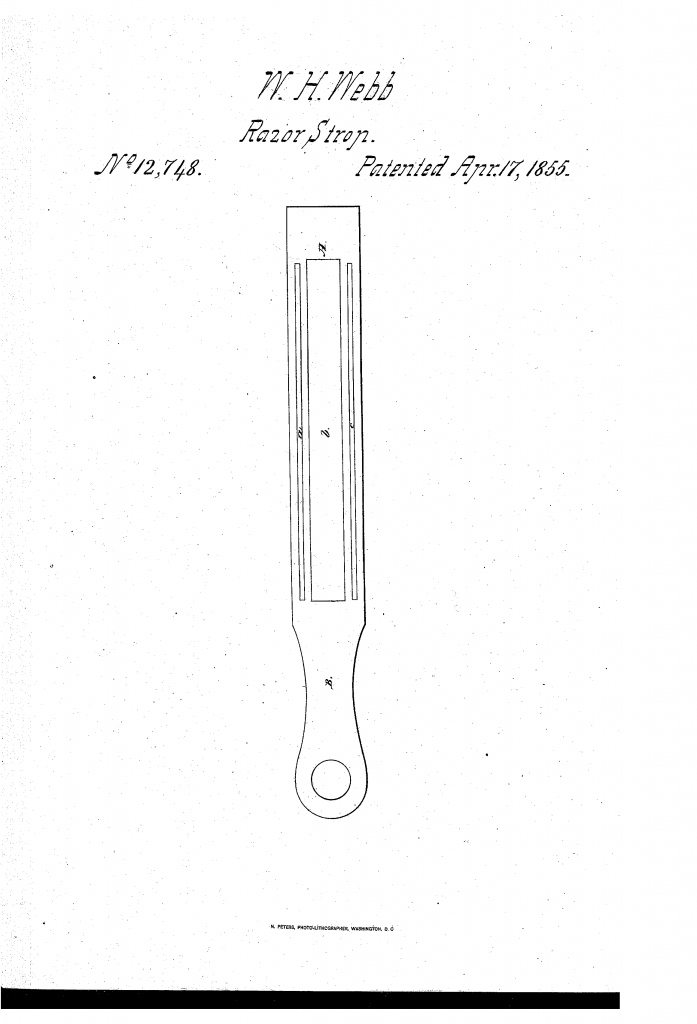Every age has its share of cranks and quacks. These are usually found peddling the miracle cure of the day – be it radioactivity, magnetism, or – as it was in the middle of the 19th century – electricity. And after reading the patent description for a metallic hone, I’m unsure if old William was a crank or a quack.
William was awarded his patent in 1855, making this one of the oldest patents I’ve looked at so far. And to William’s defence, this is one of the more straightforward and easy to read patents I’ve seen in a while.
The metallic hone was, as the name implies, made of metal. William suggested a soft metal, such as sink, for the main body. In the body, with the upper surfaces flush, were three strips of harder metal – William suggest copper, steel, or silver. This, he supposed and believed, would produce an electric current when the hone was wetted with water or oil
And he wasn’t wrong about that. The difference in electrochemical potential between the different metals would cause a current to run when an electrolyte is added. Depending on which of the harder metal is used, the current would be between 1.1 and 1.5 volts.
Where Williams takes a hard left and leaves science behind, is when he argues that this promotes the sharpening of the razor somehow. Although he don’t labour that point to hard, as can be seen from the patent text:
It is supposed and believed that when the surface of the strop is covered with oil or a liquid an electric current is produced, which pro motes in some way the process of sharpening a razor when it is passed back and forth on the strop and the rubbing-surface of the strop has been covered with a sharpening paste or matter. It is not intended to assert it as a fact that such an electric action really occurs, but it is certain that the softer metal, in connection with the harder strip or strips operates to great advantage in sharpening and putting a fine edge on a razor or any delicate surgical instrument.
From US patent 12,748
And William was doing the right thing when he hedged his bets. Running a current through a metallic hone is unlikely help with the honing of a razor. What it will do, on the other hand, is to make sure your metallic hone will suffer galvanic corrosion. And that will eat away the soft sink in fairly short order – after all, sink is used as the sacrificial anode on steel ships.

William also offers a second explanation as to how his metallic hone worked. One that is better grounded in reaility:
When the razor is honed on the hone the softer metal seizes and retains the
From US patent 12,748
sharpening material and enables it to Wear down the blade, the strips of harder metal serving at the same time, or while the blade is moved on the hone, to smooth down or polish the abraded edge. It is very probable that the edges of the harder strips contribute to the removal of the metal from the side of the blade.
I was initially a little sceptical to using a metal hone to sharpen a razor, I do use a sharpening steel to maintain the edge on my kitchen knife. And some of them can get razor sharp… So it is likely that William’s metallic hone mostly worked as my kitchen steel does – even if William implied otherwise.
But to be fair; William is far from the only inventor of shaving related gear that has descended into crankery. There is something about sharpening razors and blades that attracts madness I guess.
You can read the full patent over at Google Patents.

Pingback: William H Webb's metallic hone - Razors n Blades the shave that saves
Pingback: Metallic razor strop from 1859 - Wegian WetshavingWegian Wetshaving
Pingback: Improvement in razor strops - Wegian WetshavingWegian Wetshaving